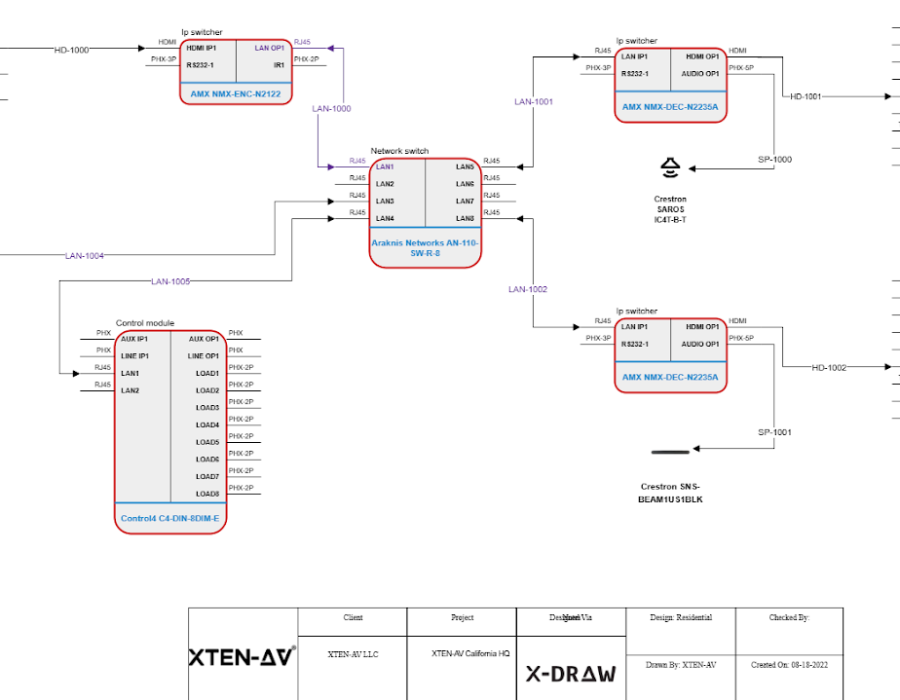XTEN-AV is a versatile platform that has redefined design workflows for AV professionals, IT integrators, and engineers. Known for AI powered automation, rack diagram generation, and cloud based collaboration, XTEN-AV is a strong contender among AutoCAD Alternatives. It provides intuitive tools for creating complex 2D and 3D designs while streamlining workflows through automation and real time collaboration. Despite its many advantages, however, some engineers remain loyal to AutoCAD due to its long standing presence, extensive feature set, and industry standard status. XTEN-AV demonstrates that modern AutoCAD Alternatives can deliver efficiency, accuracy, and accessibility, yet the pull of AutoCAD remains strong for certain professionals.
Introduction
AutoCAD has been the industry standard for decades, providing engineers, architects, and designers with powerful tools for drafting, modeling, and documentation. Its widespread adoption, robust feature set, and compatibility with professional workflows have made it the go to choice for many technical fields.
Despite the emergence of multiple AutoCAD Alternatives, some engineers remain steadfastly committed to AutoCAD. These alternatives offer features such as cloud backups, AI powered generative design, and real time collaboration, yet AutoCAD retains a loyal user base. Understanding why some engineers resist switching provides insights into the strengths of traditional CAD software, as well as the challenges of adopting newer platforms.
Why Engineers Stick With AutoCAD
Several reasons explain why some engineers will never leave AutoCAD, even when alternatives exist:
1 Industry Standard
AutoCAD is deeply embedded in many industries. Large engineering firms, construction companies, and government projects often require DWG compatibility and established CAD workflows. Engineers who work on these projects cannot risk using software that is not universally recognized. AutoCAD Alternatives may offer comparable features, but they may not guarantee seamless integration with existing projects or client requirements.
2 Familiarity and Comfort
Years of experience with AutoCAD create a level of comfort that is hard to replace. Engineers develop muscle memory, shortcuts, and workflows optimized for AutoCAD. Switching to an AutoCAD Alternative requires retraining, adjustment, and adaptation to a different interface, which can temporarily reduce productivity. Many engineers prefer to stick with what they know, especially when deadlines are tight and errors are costly.
3 Advanced Features
AutoCAD provides a comprehensive set of advanced features for 2D drafting, 3D modeling, parametric design, and documentation. Some AutoCAD Alternatives, including XTEN-AV, Fusion 360, and BricsCAD, offer similar capabilities, but certain niche tools, industry specific plugins, or legacy features may only be available in AutoCAD. Engineers working on specialized projects may rely on these advanced tools and cannot compromise functionality.
4 Established Support and Community
AutoCAD benefits from decades of documentation, tutorials, forums, and expert communities. Engineers can easily find solutions to problems, best practices, and training resources. Newer AutoCAD Alternatives may have smaller support ecosystems, which can be a barrier for professionals who require quick assistance and reliable guidance.
5 Compatibility and File Standards
Many projects rely on DWG and DXF file formats that are native to AutoCAD. While most AutoCAD Alternatives support these formats, compatibility issues may occasionally arise, especially with complex drawings or proprietary extensions. Engineers working on collaborative projects with multiple stakeholders often prefer the reliability of staying within AutoCAD’s ecosystem.
Why AutoCAD Alternatives Still Matter
Despite the loyalty to AutoCAD, AutoCAD Alternatives offer significant advantages that attract engineers, particularly in modern workflows:
- Cloud Based Collaboration. Platforms like XTEN-AV allow real time teamwork and remote access to projects, which is difficult to achieve with traditional AutoCAD.
- AI Powered Automation. Alternatives can automate repetitive tasks such as equipment placement, cable routing, and layout optimization, saving time and reducing errors.
- Cost Efficiency. Free or subscription based alternatives lower the financial barrier for startups, small businesses, and individual engineers.
- Generative Design. Modern alternatives provide generative design tools that explore multiple design options quickly, something traditional AutoCAD lacks.
- Flexibility. Open source or modular platforms allow engineers to customize workflows and integrate with other tools seamlessly.
XTEN-AV exemplifies these benefits by combining cloud access, AI automation, and real time collaboration while remaining accessible to engineers transitioning from AutoCAD.
The Middle Ground: Hybrid Workflows
Many engineers adopt a hybrid approach, using AutoCAD for core drafting and documentation while leveraging AutoCAD Alternatives for specialized tasks, collaboration, or AI driven optimization. This approach allows engineers to maintain the reliability and familiarity of AutoCAD while taking advantage of modern features that enhance efficiency. Platforms like XTEN-AV can complement AutoCAD by providing advanced visualization, rack layout automation, and cloud based storage, making hybrid workflows practical and effective.
Conclusion
Some engineers will never leave AutoCAD because of its entrenched industry status, familiarity, advanced features, robust support, and file compatibility. However, the rise of AutoCAD Alternatives demonstrates that modern platforms can provide powerful tools for collaboration, automation, and cloud based workflows.
XTEN-AV, in particular, highlights how AI powered design, real time collaboration, and cloud backups can complement traditional CAD workflows while offering a glimpse into the future of engineering design. For many professionals, the solution is not abandoning AutoCAD entirely but integrating alternatives to enhance productivity, reduce repetitive work, and embrace modern features without sacrificing reliability.
In the end, AutoCAD remains indispensable for certain engineers, but the combination of AutoCAD and smart alternatives like XTEN-AV ensures that teams can enjoy the best of both worlds: tradition, stability, and innovation.
Read more: https://www.help4seo.com/autocad-alternatives-that-provide-better-cloud-backups/





Comments